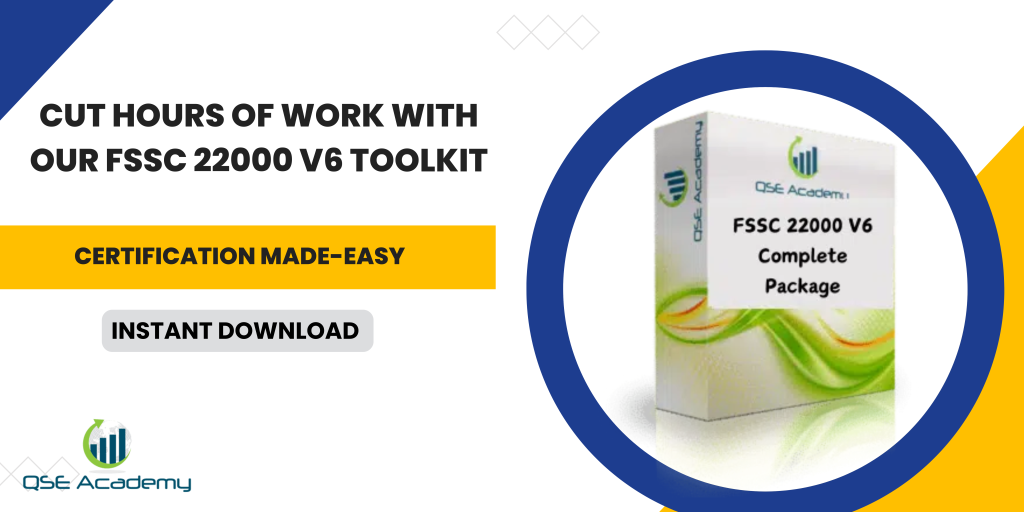FSSC 22000 V6 Project Plan Template
Why a Clear Project Plan Changes Everything
When teams start working toward FSSC 22000 V6 certification, they often feel overwhelmed. There’s documentation to write, training to plan, PRPs to update, and auditors to prepare for. It’s a lot.
At QSE Academy, we’ve guided hundreds of food businesses—from bakeries to packaging plants—through this exact journey. And every successful project we’ve seen had one thing in common: a structured project plan.
This article breaks down that plan into actionable stages. You’ll learn how to:
- Set a solid foundation with the right scope and timeline.
- Turn FSSC requirements into manageable tasks.
- Build documentation and training around your operations.
- Prepare for audits without last-minute panic.
If you follow this roadmap, you’ll have a clear, realistic, and trackable plan that gets your organization certification-ready on time.
Setting the Foundation — Define Scope, Team, and Timeline
Here’s what I’ve noticed: most implementation problems start because the foundation was rushed. You can’t build an FSMS if no one’s sure what’s included or who’s leading what.
Start with your scope.
Define which products, sites, and processes the FSSC 22000 certification will cover. Be specific—it avoids confusion later when your auditor checks the scope statement.
Next, assign your project team.
You’ll need a Food Safety Team Leader, a QA Manager, a Production Head, and a Documentation Coordinator at minimum. Everyone must know their responsibilities and authority level.
Then, build your timeline.
Work backward from your desired certification date. Break it down by phase:
- Gap Analysis (Weeks 1–3)
- Documentation & Training (Weeks 4–10)
- Implementation & Internal Audit (Weeks 11–18)
- Certification Audit (Weeks 19–24)
Pro Tip: Map your milestones on a shared calendar or Gantt chart. Seeing the timeline visually keeps the project on track.
Common Mistake: Jumping straight into writing procedures before finalizing scope. That’s how you end up rewriting documents two months later.
 Gap Analysis & Action Planning — Turn Requirements into Tasks
Gap Analysis & Action Planning — Turn Requirements into Tasks
Once your team is set, the next move is running a gap analysis.
Compare your current food-safety practices against:
- ISO 22000:2018 (core FSMS requirements),
- ISO/TS 22002-x (PRP standards), and
- FSSC V6 Additional Requirements like food-safety culture and allergen management.
Use a Clause vs Status vs Action Plan matrix. It’s simple but powerful. For each clause, ask:
- Is this already in place?
- What’s missing?
- Who’s responsible for closing the gap?
- By when?
Example:
If traceability testing isn’t documented, assign QA to design and test a recall drill by Week 5.
Pro Tip: Hold weekly reviews to track task progress. A visible dashboard (Excel, Trello, or your QMS software) makes accountability easy.
Common Pitfall: Giving one person too many clauses. Spread ownership—your food safety system only works if it’s built by the people who run it.
Documentation & Training Plan — Build Your FSSC Toolkit
Now that you know your gaps, it’s time to fill them with the right documents and training.
Start by drafting your Food Safety Manual—it’s the backbone of your FSMS. Then move to your PRP procedures (cleaning, pest control, allergen management, maintenance, etc.) and required records.
But here’s what matters: write procedures that reflect your actual processes, not generic templates. Auditors can tell the difference immediately.
Next, plan your training.
Schedule awareness sessions for all employees, and specific training for internal auditors and key personnel.
Example:
A frozen-food plant we helped in Malaysia cut audit findings in half after scheduling short refresher trainings every two weeks instead of one big session.
Pro Tip: Link every training to a documented competency matrix. It shows auditors you’re serious about continuous learning.
Common Mistake: Treating training as a one-off event. FSSC 22000 V6 expects culture development—not a checkbox.
Implementation & Internal Audit Schedule — Make It Operational
This is where the plan moves from paper to practice.
Start implementing your new procedures—begin with high-risk processes like CCPs, PRPs, and supplier control.
Once operations stabilize, schedule your internal audits. Ideally, complete a full cycle before the certification audit. Your goal is to test the entire system and find issues before your auditor does.
Conduct a management review after your first audit cycle. Use real data—KPI trends, customer complaints, audit results—to show top management engagement.
Pro Tip: Run a mock audit. It’s the single best way to uncover small issues early.
Common Mistake: Skipping this step to save time. In every case I’ve seen, that decision backfires during Stage 1.
Certification Readiness Checklist — From Stage 1 to Stage 2
By now, your system should be running smoothly. It’s time to check if you’re ready for certification.
Stage 1 Preparation:
Gather documents—Food Safety Manual, training records, monitoring logs, internal audit reports, and management review minutes.
Stage 2 Preparation:
Simulate a full audit. Walk through traceability exercises and recall tests. Verify that PRPs are consistently applied.
Coordinate with your Certification Body.
Confirm the audit scope, audit plan, and on-site dates. Make sure your category (food manufacturing, packaging, storage, etc.) matches the right ISO/TS 22002-x standard.
Pro Tip: Conduct a “pre-audit review” two weeks before Stage 1. You’ll fix small gaps without pressure.
Maintaining and Improving the Plan — Post-Certification Cycle
Getting certified is one thing. Staying certified is another.
Your project plan should evolve after certification. Update it every year with:
- Surveillance audit dates
- Internal audit schedule
- New training needs
- Updates from the FSSC Foundation or ISO
Pro Tip: Treat your plan as a living document, not an archive. Each time you discover an issue—during an audit or complaint investigation—note it in the plan and assign an improvement task.
Example:
One beverage processor started tracking their corrective actions directly in their FSSC project plan. The result? A 30 % drop in repeat nonconformities within a year.
Common Mistake: Filing the project plan away once the certificate arrives. That’s how systems stagnate.
FAQs — Practical Answers for FSSC 22000 Project Planning
Q1. How long does it take to implement FSSC 22000 V6?
It depends on your starting point. Most small-to-medium businesses need 6 to 12 months from gap analysis to certification audit.
Q2. Can I use a pre-made FSSC project plan template?
Absolutely—but customize it. A template gives structure, but your actual steps must reflect your operations and product category.
Q3. What usually causes project delays?
Unclear scope, poor communication, and lack of ownership. A visible, shared plan solves most of these issues early.
Conclusion — Start Your FSSC 22000 V6 Journey with Confidence
A well-structured FSSC 22000 V6 Project Plan isn’t just paperwork—it’s your roadmap to a smooth, successful certification. It saves time, prevents confusion, and builds confidence across your team.
At QSE Academy, we’ve seen organizations transform chaotic projects into seamless implementations using this exact template.
If you’re ready to take the next step, download our FSSC 22000 V6 Project Plan Template and start managing your certification like a pro.
Melissa Lavaro is a seasoned ISO consultant and an enthusiastic advocate for quality management standards. With a rich experience in conducting audits and providing consultancy services, Melissa specializes in helping organizations implement and adapt to ISO standards. Her passion for quality management is evident in her hands-on approach and deep understanding of the regulatory frameworks. Melissa’s expertise and energetic commitment make her a sought-after consultant, dedicated to elevating organizational compliance and performance through practical, insightful guidance.








